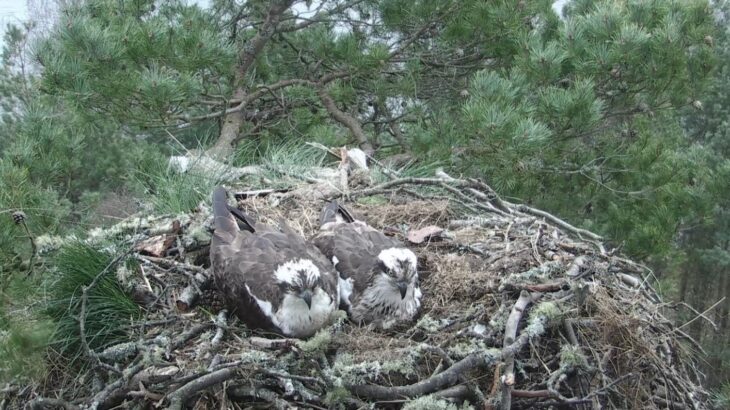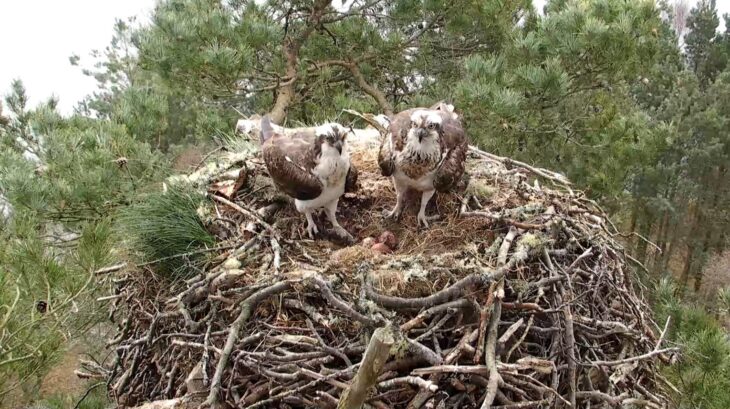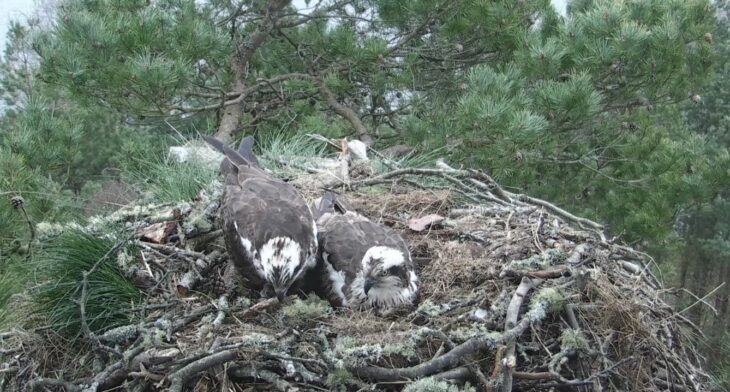How to tell LM12 and LF15 apart
It can sometimes be quite hard to differentiate between the two breeding ospreys at Loch of the Lowes, male LM12 and female LF15. To make things easier this guide highlights the differences between the pair, and will hopefully help you to tell them apart.
As with all raptors, the female osprey is up to a third bigger in size, however there are a lot of more subtle identifying features that can be used to tell them apart, since they won’t always be conveniently sitting side by side.
To make things tricky, neither of our resident birds has a leg ring, and they have to be identified solely by physical features. Thankfully, there are a few tell-tale signs for each bird.
We’ll start with the most obvious features. The first can be seen when the pair happen to look towards the camera, where each has a distinctive head stripe running down the front of their heads. With LF15 you can see a nice Y shape where it spreads out at the top. LM12’s forehead marking on the other hand is much straighter and has a less distinctive fork at the top. Have a look at the photo below and see if you can tell who is who.

Hopefully when looking at this picture you can see that the head stripe of the bird on the right fans out a bit at the top to create that nice ‘Y’ shape, so for all of you who guessed the female is the right-hand bird well done! But not to worry, there are plenty other features which set them apart.
When they are facing the camera the next best feature you can use besides the head stripe is the patterning on the chest, the photo below demonstrates this very well, as you can see the female has a much darker chest with a ‘necklace’ across her chest. Whereas the male has a much lighter chest with fewer markings. Have a look at the photo and see if you can spot this difference in patterning.

Another good trait which you can use to distinguish them is the overlap of the wings: LM12’s wing tips stretch out past his tail feathers and extend much further than the female’s, forming a distinctive ‘V’ shape. The picture below demonstrates this quite well. It also shows all the other distinguishing features, so you can see his ‘V’ wing overlap, his narrower head stripe and the ‘Spanish dancer’ on the back of his head. This head mark is complete with skirts and arms waving castanets, all be it an upside-down dancer.

One aspect which is not quite as obvious, but which can sometimes be used is seen when the male sits on the nest. He will often sit in a distinctive way where he has his wingtips sitting more spread out, with the wingtips sitting parallel to each other instead of overlapping. You can see this in the photo below with the male on the left with his distinctive wing positioning and the female on the right. You can also see that he is somewhat less mottled than the female and has a much more dark, sleek appearance compared to LF15 who is lighter and often more ruffled in appearance.


LM12 being quite keen to take on incubation duty whenever he can we will see constant switching of nest duties between the male and the female. So hopefully now after reading this you will be able to tell confidently which of our resident pair is sitting on the nest.
Johnny & Nick
Species Protection Officers
Our Osprey Protection Programme at Loch of the Lowes is supported by players of People’s Postcode Lottery.
Help protect Scotland’s wildlife
Our work to save Scotland’s wildlife is made possible thanks to the generosity of our members and supporters.
Join today from just £3 a month to help protect the species you love.
Preface
It can sometimes be quite hard to differentiate between the two breeding ospreys at Loch of the Lowes, male LM12 and female LF15. To make things easier this guide highlights …
